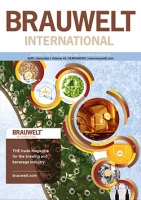The authors are working worldwide with lauter tun plants from renowned breweries and
The Mauritius Brewery, located in Zwickau, Germany recently purchased new palletizers for use in their bottling plant. The contract for the new palletizing system was awarded to the equipment manufacturer Beyer based in Rosswein in Saxony. The new, high performance palletizing technology is described in detail below.
Using only thermodynamic substance property data, this article is meant to show, in a generally understandable fashion, the enormous savings potential associated with an overall evaporation rate reduction, disregarding brewery-specific efficiency losses in generation of heat from primary energy. Generalised simplified relationships are used to show the degree to which energy can be saved in every brewery as a function of annual output, by reducing overall evaporation per hectolitre of wort that does not have to be evaporated.
Very often analysis results from samples taken during brewhouse inspections for subsequent testing, for monitoring wort quality and other brewhouse procedures or for calculating overall brewhouse yield (OBY) are inaccurate or false, simply because the samples were not collected or handled in the proper manner.
“Our combination filling and packaging system is equipped to handle a variety of disposable and returnable containers such as returnable flip-top bottles, disposable bottles, cans and NRW-style bottles. This line assembles orders anywhere from 20 pallets to several hundred pallets in cooperation with the ordering and warehousing departments,” relates Uwe Daebel, production manager of the Paulaner Brewery in Munich as he describes the demands placed on the Krones line which was recently installed for Hacker-Pschorr and Paulaner products.
These days, an exact determination of total evaporation during the wort handling process is becoming increasingly important. One method measures the extract
The breweries Häberlen in Gaildorf and Franken Bräu in Riedbach now have new fillers from Vipoll d.o.o., based in Krzievci pri Ljutumeru, Slovenia.
In planning the brewhouse of the future, it must be taken into consideration that the trend towards brewing a larger number of batches per day is on the rise, essentially reducing the amount of grist per batch. Increasing the number of batches per day and reducing the size of the batches addresses the need to minimize energy peaks and could also result in significant savings due to the smaller dimensions of the brewhouse equipment.
At the Technical Brewing Seminar 2007 in Tokyo, Prof. Dr. Narziß provided an excellent overview of current technology and its significance in determining beer quality, beginning his discussion with barley and malt, progressing through brewhouse operations, fermentation and maturation.
The first part of this article provides an overview of state-of-the-art of CO2 recovery. In the second part, a newly developed process is compared to established processes. Results from research and development of the new recovery process are presented. Pointers to assist in decisions relating to new investments are given.
The beverage industry has long been seeking a practicable system for filtering out the contaminants from a bottle washer’s operating media. With the development of Parsifal micro-filtration, this technological challenge has now been solved, in terms of both operational economy and qualitative excellence.


